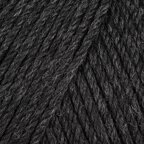- Digitale Artikel sind nicht in den Versandkosten enthalten (siehe unsere Lieferseite (öffnet sich in einem neuen Tab) für weitere Informationen).
Was du brauchen wirst
| One size only: | Finished size depends on yarn used |
|---|---|
| Cascade Yarns 220 Superwash | |
Cascade Yarns 220 Superwash
 Jet (1913) Jet (1913) | 2 |
| Schachenmayr Catania Fine | |
Schachenmayr Catania Fine
 Weiss (01000) Weiss (01000) | 1 |
| Werkzeuge & Sonstige Vorräte | |
| 3,50mm GeradeStricknadeln – 20cm (öffnet sich in einem neuen Tab) | |
Ist etwas nicht in Ordnung?
Lass es uns hier wissen.
Produktdetails
The skunk is one of the more difficult patterns because of the fur-stitched tail and the stripes that need to be sewn on – in the case of the tail, over the top of the fur loop stitches, which can be frustrating. Despite the difficulty of getting the tail and stripes right, however, this is one of my favorite patterns.
You need to have…
- Yarn in desired color(s) and weight (~6oz/100g for sport weight; ~24oz/700g for worsted)
- Contrast yarn for eyes and nostrils
- Knitting needles at least 2 sizes smaller than those recommended for the yarn being used
- Dark contrast yarn for eyes
- Pink contrast yarn for nose and mouth
- Stuffing
- Tapestry needle
You need to know (or learn)…
- Stockinette stitch
- Increase and decrease stitches
- Mattress stitch for sewing seams
- Fur or loop stitch (for tail and stripes)
- Basic color change techniques (optional)
- Hersteller
- Unabhängiger Designer
- Handarbeit
- Knitting
- Designer
- Sherri Sagers
- Druckformat
- Herunterladbares PDF
- Sprache
- Englisch
- Notizen
- Fingering yarn works well for the stripes, but you'll have to hold 2-3 strands as you go. Having more strands per loop makes the stripes look fluffier
- Anleitungen
- 1
- Seiten
- 14
- Schwierigkeit
- Fortgeschritten
- Garnstärke
4-Ply (3,50 mm)
Sport (3,50-3,75 mm)
Worsted (4,50-5,50 mm)



